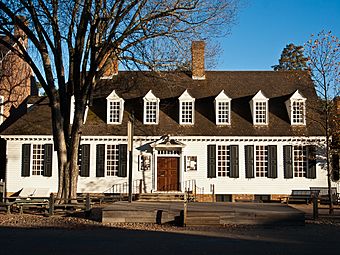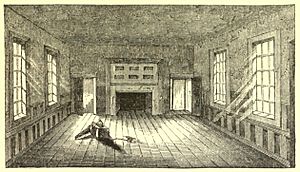Raleigh Tavern facts for kids
Quick facts for kids |
|
|
Raleigh Tavern
|
|
|
U.S. National Historic Landmark District
Contributing Property |
|

Reconstructed Raleigh Tavern from Duke of Gloucester Street
|
|
| Location | Williamsburg, Virginia |
|---|---|
| Built | 1930-31 |
| Architectural style | Colonial Revival |
| Part of | Williamsburg Historic District (ID66000925) |
| Added to NRHP | October 15, 1966 |
The Raleigh Tavern was a famous meeting place in Williamsburg, Virginia, during the time when America was becoming independent. It was one of the biggest taverns in colonial Virginia. People gathered here, especially lawmakers, when the King's governors tried to stop them from meeting. It was also where the Phi Beta Kappa Society, a well-known student group, was started on December 5, 1776.
Today, the Raleigh Tavern you see was rebuilt in 1930–31. It was the very first building to be rebuilt and opened as part of Colonial Williamsburg. Unlike some other old taverns in Williamsburg that are now restaurants, the Raleigh Tavern is a museum. It shows visitors what a tavern looked like and how it was used long ago.
The tavern was named after Sir Walter Raleigh, an important person in England's early efforts to settle Virginia. A metal statue of Raleigh's head was placed above the entrance door.
History of the Tavern
From 1699 to 1779, Williamsburg was the capital city of the Virginia colony. Because of this, many taverns were built to host lawmakers and other visitors. These people came to do business with the government when the House of Burgesses (Virginia's elected lawmaking group) was meeting.
The original Raleigh Tavern was likely built before 1735. It changed owners many times but always stayed a tavern. In 1767, a local cabinetmaker named Anthony Hay bought it.
The Raleigh Tavern was a very important place in Williamsburg. Big parties and meetings were held there. For example, two royal governors, Robert Dinwiddie and Lord Botetourt, had special welcome dinners at the tavern when they first arrived in Virginia.
A Place for Freedom
In May 1769, the Raleigh Tavern became a key spot for people who wanted more freedom from Britain. Governor Botetourt closed down the House of Burgesses because they spoke out against new British taxes called the Townshend Acts. Right after being closed, the lawmakers met secretly in the Apollo Room of the tavern. There, they signed the Non-Importation Agreement, agreeing not to buy British goods. The governor later allowed the House of Burgesses to meet again.
This Apollo Room was a frequent meeting spot for important leaders like Thomas Jefferson and Patrick Henry. They met here in 1773 to create groups that would share news between the different colonies. When Governor Dunmore again closed the Burgesses, they met once more in the Apollo Room in May 1774.
Years later, in 1824, the famous French hero Marquis de Lafayette was honored with a special dinner at the tavern. The building continued to be used as a tavern until it was burned down on purpose in 1859.
Tavern Architecture
The Raleigh Tavern you see today looks like the original building. It is an L-shaped building made of white weatherboard (wooden planks). It has 18 windows that stick out from the roof, called dormer windows.
The main room of the Raleigh Tavern was a large dining and party hall known as the Apollo Room. People at the time said that a Latin phrase was written above the fireplace: Hilaritas sapientiae et bonae vitae proles. This means "jollity is the offspring of wisdom and good living." A historian named Lyon Gardiner Tyler wrote that this room probably saw more fun parties and important political meetings than any other room in North America.
Rebuilding the Tavern
The Raleigh Tavern was rebuilt in 1930–31 on the exact spot where the original building stood. Virginia Governor John Garland Pollard was there for the opening ceremony. The tavern opened to the public on September 16, 1932. This event marked the official opening of Colonial Williamsburg.
The rebuilt Raleigh Tavern is one of the most popular places to visit in Colonial Williamsburg. Colonial Williamsburg is a living history museum that shows what life was like in Virginia's capital city long ago. The tavern stands on Duke of Gloucester Street, and it looks different from the grand Capitol Building nearby.



